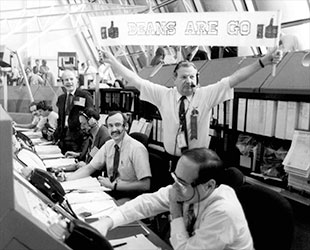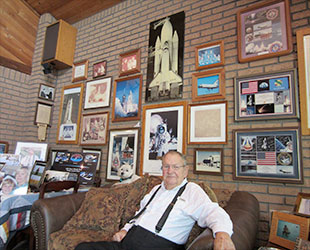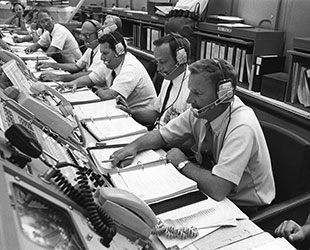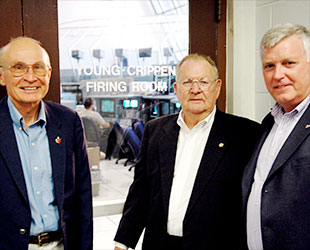 advertisements advertisements
|

|
Norm Carlson, NASA test director who gave 'go' for Saturn V, shuttle and beans, dies

NASA test director Norm Carlson holds up a sign reading "Beans Are Go" after the launch of the space shuttle Discovery's STS-26 mission in 1988. Carlson, 81, died on March 1, 2015. (NASA) |
March 3, 2015 — When NASA astronauts next launch to space from Florida, the flight control team that oversees their liftoff may celebrate with a traditional crock of beans.
If they do, they will be honoring Norm Carlson, too.
The test director who oversaw the launch countdowns for Apollo 11, the first moon landing in 1969, and STS-1, the first space shuttle flight in 1981 — as well as many more missions, Carlson died Sunday (March 1) of complications from congestive heart failure. He was 81.
"Norm left us his recipe," Bob Cabana, director of NASA's Kennedy Space Center in Florida and former space shuttle astronaut, said in a statement. "He started the tradition of cooking beans for the team in the Launch Control Center, which grew from a single crock pot at the beginning, to a spread we all grew accustomed to partaking in."
But celebratory beans (and cornbread, another part of the tradition) were not the only element that Carlson added to the countdown. The man who gave the "go" for Saturn V boosters and shuttle orbiters to launch, is credited by his peers for devising the count's embedded stops.

Norm Carlson at home in Titusville, Fla. in 2013. (Jonathan Ward) |
"The built-in hold came about from us trying to put some padding into the overall timeline," Carlson said in a recent interview with Jonathan Ward, the author of the upcoming books "Countdown to Apollo 11" and "The Rocket Ranch" (Springer-Praxis). "It didn't change T-zero. It simply added more time than actually showed on the procedure."
"The hold was catch-up time, in case we were behind and had things that we hadn't done yet but we should have. If you didn't need it, you didn't need it," Carlson said.
Carlson arrived at the Kennedy Space Center in 1964, four years after earning a mechanical engineering degree from Oklahoma State University and accepting a job at NASA's Marshall Space Flight Center in Alabama.
"I saw a sign, 'Engineers wanted,' at a civil service office," Carlson recounted to Ward. "I filled out an application, and a week later I got a call from the NASA personnel office in Huntsville. I borrowed $500 from my dad, threw my four-year-old son and my wife in my 1960 Valiant, and headed for Huntsville."
"I came to the Marshall test lab, design section, working on the drawing board. I didn't like it," he admitted. "I was there for six months and transferred over to booster test. I like that fire and smoke! It's a lot more exciting!"

Norm Carlson, as launch vehicle test conductor, mans a console during the countdown demonstration test for Apollo 11. (NASA) |
After transferring to Florida, Carlson's first launches were the early Saturn I and Saturn IB test flights. Carlson then began working the manned Apollo missions.
"Prior to Apollo 11, we had launched 20 Saturn vehicles," he stated. "I felt quite confident in the launch system. The spacecraft, I didn't know about personally, but I never had any doubt at all about the launch vehicle. Never."
It was Carlson, as the launch vehicle test conductor, who gave the "go" for Apollo 11's Saturn V to fly, but he did not care for "go/no go" polls that Houston Mission Control ran.
"I made the rule that if somebody has a problem, you stand up and say so immediately. I want to know now. I don't want to wait until I'm at two minutes prior to T-zero," Carlson said. "We're not going to have a damn poll. If you listen to Mission Control, they have all their polls, maybe a dozen of them. "FIDO Go!" That's just a big show. There is no value added, as far as I'm concerned."
Other test conductors disagreed, but Ike Rigell, the chief engineer for Apollo 11, backed Carlson.
"Ike sided with me that the poll wasn't necessary," stated Carlson. "It would be much better if everybody says that they have a problem when they have a problem."
"If something's wrong, tell me now — don't wait until you're asked, "Do you have a problem?"

Norm Carlson (center) is seen in 2006 with launch director Bob Sieck (left) and Jim Kennedy, then-director of the Kennedy Space Center, at the "Young-Crippen Firing Room" dedication. (NASA) |
After Apollo ended in 1975, Carlson went to Edwards Air Force Base in California for approach and landing tests with the prototype shuttle Enterprise. He then returned to Florida to serve as test director for the maiden mission of Columbia, STS-1, in 1981. It was a role he would serve for most of the first half of the 30-year space shuttle program.
"He became chief test director and was the consummate professional, working tirelessly to ensure the success of the missions and the safety of all of the astronauts," said Cabana.
Carlson retired in 1995, just before NASA's 100th crewed flight. He continued to attend launches, bringing barbecue pork and potato salad to Kennedy's Launch Control Center for his former team's pre-launch meals.
And the beans continued to be "go," just as a banner he held up after the launch of the space shuttle Discovery in 1988 read. |

© collectSPACE. All rights reserved.

|
|

|
Feedback: Messages

Successful Launch Beans Recipe
Courtesy of Norm Carlson via NASA
Put 6 pounds of dried great northern beans in an 18-qt electric cooker.
Cut 10 pounds of smoked ham into cubes.
Add ham and ham bones to beans.
Add 1/2 shaker of lemon pepper.
Add 3 pounds chopped onions.
Add 2 stalks chopped celery.
Add 1 tablespoon of liquid smoke.
Cover with water and cook for at least 8 hours.

|
|

|
